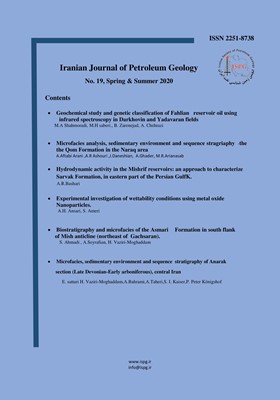Designing an Ensemble model for estimating the permeability of a hydrocarbon reservoir by petrophysical lithology Labeling
Subject Areas : Petrophysicsabbas salahshoor 1 , Ahmad Gaeini 2 , Alireza shahin 3 , mossayeb kamari 4
1 -
2 -
3 -
4 -
Keywords: permeability, Ensemble model, lithology, machine learning, petrophysical Logs,
Abstract :
Permeability is one of the important characteristics of oil and gas reservoirs that is difficult to predict. In the present solution, experimental and regression models are used to predict permeability, which includes time and high costs associated with laboratory measurements. Recently, machine learning algorithms have been used to predict permeability due to better predictability. In this study, a new ensemble machine learning model for permeability prediction in oil and gas reservoirs is introduced. In this method, the input data are labeled using the lithology information of the logs and divided into a number of categories and each category was modeled by machine learning algorithm. Unlike previous studies that worked independently on models, here we were able to predict the accuracy of such a square mean error by designing a group model using ETR, DTR, GBR algorithms and petrophysical data. Improve dramatically and predict permeability with 99.82% accuracy. The results showed that group models have a great effect on improving the accuracy of permeability prediction compared to individual models and also the separation of samples based on lithology information was a reason to optimize the Trojan estimate compared to previous studies.
[1]. North F.K (1985) Petroleum Geology, Allen & Unwin.
[2]. Ramzi H.R (1998) Well Logging, SANAM Publishing.
[3]. Oberto S. (1984) Fundamentals of Well-Log Interpretation - The Acquisition of Logging Data, Elsevier.
[4]. Ayyadevara V. (2018) Pro Machine Learning Algorithms, Apress.
[5]. Lakhmi C. Jain (2016) Foundations and Methods in Combinatorial and Statistical Data Analysis and Clustering, Springer Press.
[6]. Shalev-Schwartz Sh. (2014) understanding-machine-learning-theory-algorithms, Cambridge University Press.
[7]. Mitchell M. (1997) Machine-Learning-Tom-Mitchell, McGraw-Hill.
[8]. Ahmadi Mohammad ali Zhangxing Chen (2018), Comparison of machine learning methods for estimating permeability and porosity of oil reservoirs via Petro-physical logs, KeAi Elsevier,6,2:831-844.
[9]. Adeniran A. (2019) A competitive ensemble model for permeability prediction in heterogeneous oil and gas reservoirs, Elsevier Paper, 4, 80:353-367.
[10]. Waszkiewicz S., rakowska-Madejska P., Puskarczyk E. (2019), Estimation of absolute permeability using artificial neural networks (Multilayer perceptron) based on well logs and laboratory data from Silurian and Ordovician deposits in SE Poland, Springer, 6, 67:1885–1894.
[11] Fatai A., Abdulazeez A., Abdullatif A. (2013), Improved Permeability Prediction from Seismic and Log Data using Artificial Intelligence Techniques, SPE 164465, pp 1-3.
[12] Salahshoor A., Soheyli F., Kamari m. (2014), Optimization of machine learning algorithms for estimating the permeability of underground oil and gas reservoirs ", Journal of Iranian Oil Exploration and Production,3, 120: 56-62.
[13] Tayebi H., Habibniya B. (2018), A case study of carbonate reservoir permeability determination using NMR log in one of the southwestern fields of Iran, Iranian Journal of Petroleum Geology, 7, 13:43-62.
[14] Hakiminezhad H., Mirzarezaei M., Najar B. (2019), Estimation of permeability using uncertainty methods: type -2 fuzzy system, Iranian Journal of Geophysics, 12, 1: 82-91.


